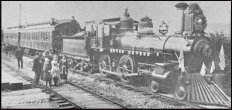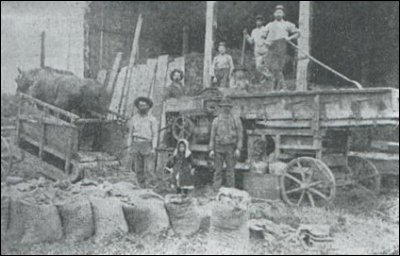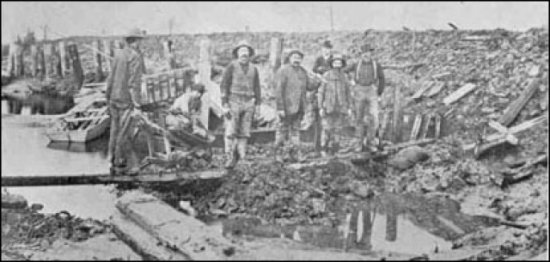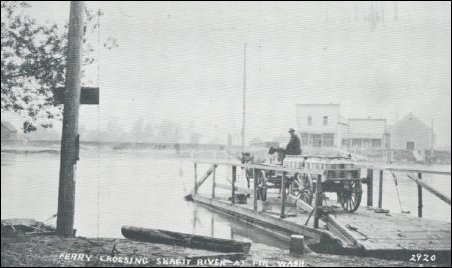Skagit River Journal
Free Resources Stories & Photos

|
Our free site remains free. How to subscribe to our separate online magazine or donate to our project |
Skagit River JournalFree Resources Stories & Photos |

|
 |
| Don Moa, a descendant of the Cornelius family of Pleasant Ridge, loaned us this copy of a photo of threshing crew on Fir island near the turn of the twentieth century. We hope that a reader will have photos or documents about the families mentioned in this story. |

|
|
This photo of a dikes crew on Fir island is from the book, Skagit Settlers, which is still for sale at the LaConner museum. All the family members listed in this story witnessed the back-breaking work needed to keep sea water out and to keep the river from flooding towns like Fir and Conway. |
 |
|
Mrs. Caroline Ball: she is referring to Caroline Lisk Ball, who married early South fork pioneer Joe Lisk in 1875 when he settled there and had two children by him. After Lisk died in an unknown year, in 1878 she married Jesse B. Ball, who established a logging camp and steamboat landing two miles west of Sedro. See this website for our exclusive Ball story. |

|
|
Chris Olson: Olson's name appears in the 1906 book, The Illustrated History of Skagit & Snohomish Counties: "In September 1889, shortly after coming to the sound, Mr. Woolley purchased from Ole [Borseth] and George Nelson a timber claim, which they in turn had purchased from Chris Olson, the tract consisting of forty-four acres." |

|
|
Fanny Lake 1874 was the year that the sternwheeler Fanny Lake was launched and in 1883 it sank at Dead Man's riffle, just east of future Sedro. Six years later, Joshua Green and his partners resuscitated the boat and started Green's amazing career. Read more about it in our exclusive story at this website. |

|
|
Josephine Actually the Josephine was rebuilt and a court suit over the explosion revealed that the original owner installed a defective boiler. Read more about it in our exclusive story at this website for the story.] Later that same year the Fanny Lake stemwheeler ran into a rock and sank, but was later raised and resumed its regular trips. Other boats plying the river in those early days were the Alki, a sidewheeler, Daisy, Henry Bailey, Clan McDonald and the Gleaner. |

|
|
Dr. William Thompson Dr. Thompson met a tragic death in 1902 when he accidentally drank poison when he woke up ill one night and reached for cough medicine. |

|
|
Small Pox and Indians In the book, Skagit Settlers, we learn: "In 1890 there was a smallpox epidemic among them [Indians] which spread havoc. The Skagit County Commissioners hired men to go to the camps and settlements to bury the dead and burn the infected houses, in the process wiping out much of what remained of the old Indian culture. Increasingly the remnants of the tribes were gathered on the Swinomish Reservation where poverty was extreme and tuberculosis was rampant." |

|
|
Dry Slough Dry slough was originally an actual slough — Deer slough, of the river that stretched from the North fork to Skagit bay where it emptied through many tentacles. Over the years, it was diverted and dammed and now exists as little finger streams without egress to the bay. The Haytons were on a small island created by the fingers of the slough and the Downs property was to the east and the south. Much of the Hayton land is now a beautiful bird preserve. |

|
|
Thomas Peers Hastie Jr. Read more about his family in our exclusive story at this website for the Hastie story. Thomas P. Hastie Jr.'s parents and family emigrated from England to the U.S. in 1845 and joined a wagon train to Oregon Territory in 1850. After living with his family for several years on Camano Island and Whidbey Island, Thomas Jr. settled on Fir Island in 1870. Maggie Hastie, daughter of Thomas Jr., married Eli Daniel [always known as E.D.] Davis, who was a partner in a Mount Vernon hardware store with fellow pioneer Otto Klement from 1888-1895. Davis bought out Klement and took on his cousin W.B. Davis as a partner. In 1905, the Davis cousins bought the Stanwood Hardware store, which W.B. Davis then managed.] |

|
[Ed. note: You can read more about the history of Fir at this Journal website.
|
Please report any broken links or files that do not open and we will send you the correct link. Thank you. |
|
Heirloom Gardens Natural Foods at 805B Metcalf street, the original home of Oliver Hammer Oliver Hammer Clothes Shop at 817 Metcalf street in downtown Sedro-Woolley, 82 years Bus Jungquist Furniture at 829 Metcalf street in downtown Sedro-Woolley, 36 years Peace and quiet at the Alpine RV Park, just north of Marblemount on Hwy 20 Park your RV or pitch a tent by the Skagit river, just a short driver from Winthrop or Sedro-Woolley College Way Antique Mall, 1601 E. College Way, Mount Vernon, WA 98273, (360) 848-0807 Where you will find wonderful examples of Skagit county's past, seven days a week North Cascade Ford, formerly Vern Sims Ford Ranch, West Ferry street and Crossroads/Highway 20 either on the Sedro-Woolley page or directly at www.northcascadeford.com DelNagro Masonry Brick, block, stone — See our work at the new Hammer Heritage Square See our website www.4bricklayers.com 33 years experience — 15 years as a bonded, licensed contractor in the valley Free estimates, reference, member of Sedro-Woolley Chamber  (360) 856-0101 (360) 856-0101 |
|
|
|
|
|
View Our Guestbook |
|
|
Mail copies/documents to street address: Skagit River Journal, 810 Central Ave., Sedro-Woolley, WA, 98284. |